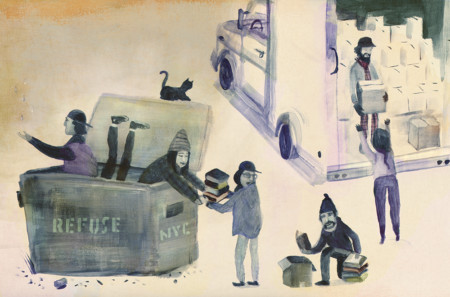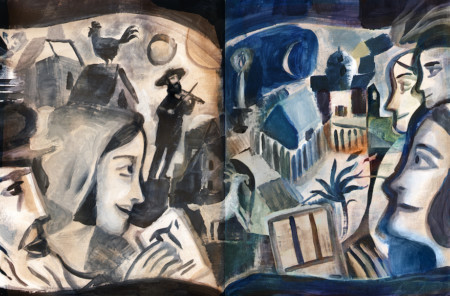Occasionally, I read picture books that I cannot wait to share with someone else. Within seconds of completing The Book Rescuers: How a Mensch from Massachusetts Saved Yiddish Literature for Generations to Come, I was suggesting the book to a friend. In just 48 pages, award-winning author, Sue Macy revealed the backstory for the Yiddish Book Center and showed how one individual, Aaron Lansky, made a difference by preserving Jewish culture. The multiple threads woven into this non-fiction picture book, along with Stacy Innerst’s authentic illustrations depicting Jewish life, made the book an obvious recipient of the 2020 Sydney Taylor Gold Medal award. The book is also a Bank Street Book of the Year.
Non-fiction picture books focusing on notable individuals introduce children to positive role models. Often the main character’s accomplishments and extraordinary traits will attract a specific audience. Picture books with the power to engage a more diverse audience or contain multiple messages are less common.
Jewish children and their parents are the primary audience for this book about Lansky’s efforts to preserve Yiddish culture. A significant number of other threads cause the book to have universal appeal.
Immigration and Assimilation
On the first page, readers learn about Lansky’s grandmother, an Eastern European Jewish immigrant, who arrived during the late 19th century to early 20th century mass migration from Europe. Like many of her peers, Lansky’s grandmother was forced to “break with the past” (Page 8) by assimilating into American culture.
Lansky could not neglect this aspect of his family’s heritage. As a young adult, he read as much as he could about Jewish history. He quickly learned that many resources were written in Yiddish, a language dismissed during the assimilation process and almost completely obliterated during the Holocaust when a massive number of Yiddish books were discarded and burned. Non-Jewish children can examine how assimilation affects immigrants’ heritage.
From Generation to Generation
Throughout history, Jews as well as other groups have shared their heritage by writing books. Spoken words can pass from one generation to the next. However, the accuracy of the message is often altered over time.
The Yiddish books collected and catalogued by Lansky open the door to understanding past generations that may have been forgotten. According to Lansky, “Books are big enough and powerful enough to define and contain identity.” (Page 21)
Like so many other cultures, Jews adhere to the practice of passing information from generation to generation (l’dor v’dor) via stories. Children from other ethnic groups can compare and contrast their experiences with Jewish traditions.

Pursuing a Passion
Lansky’s love of books and learning fueled his desire to collect Yiddish books. By going to extraordinary lengths to prevent these books from being destroyed or buried as a “sign of respect” (Page 18) for sacred texts, Lansky collected an enormous number of books. Jewish cemeteries often have graves for religious books and special texts. Lansky’s collection eventually took up most of his living space. The Yiddish Book Center stands as a testament to his perseverance and determination “to save as many Yiddish books as possible.” Page 24) Children can share stories about a cross-section of people who make a difference.

Preserving Culture
Lansky disregarded Jewish leaders who felt “Yiddish was a language whose time had passed.” (Page 25) He took extraordinary efforts to preserve Yiddish culture. In 1980, Lansky opened the Yiddish Book Center to house his growing collection. Nine years later, a “MacArthur ‘genius grant,’ given to people who make a difference in the world.” (Page 35) was awarded to Lansky. Now, Lansky’s desire to keep his grandmother’s Eastern European heritage alive allows people to learn about Yiddish culture. Children can reflect on the significance of keeping history alive.

Authentic Illustrations
After doing extensive research about Lansky and the Yiddish Book Center, Stacy Innerst, effectively borrowed a selection of Marc Chagall’s pallets and motifs. These striking images go hand-in-hand with Macy’s text. The scenes of the Jews fleeing the Holocaust and the visuals showing the transmission of culture from the past to the present are exceptional examples of how Innerst’s work adds to the authentic quality of this picture book.
Extraordinary Resources
Readers interested in learning more about Aaron Lansky, the Yiddish Book Center, and the Yiddish words used throughout the book should take time to read the final pages of the book. The publisher includes an afterward by Aaron Lanksy, an Author’s Note, an Illustrator’s Note, a Glossary of Yiddish Words and Expression, a page with additional resources and another page with Source Notes.
A SAMPLING OF RELATED PICTURE BOOKS
The Whispering Town: Exceptional Holocaust Picture Book
Picture Book Showcasing Golda Meir’s Tenacity
Multicultural Picture Book: Benjamin Tudela
Multicultural Picture Books- Yiddish Folksong
Picture Book Recalls Clara Lemlich
DISCLOSURE
I received a complimentary copy of The Book Rescuers: How a Mensch from Massachusetts Saved Yiddish Literature for Generations to Come.
BIO
Sandra Bornstein is the author of May This Be the Best Year of Your Life. Sandra’s memoir highlights her living and teaching adventure in Bangalore, India. She was a licensed Colorado teacher who taught K-12 students in the United States and abroad. Sandra also taught college-level courses at Front Range Community College and the University of Colorado-Boulder.
In addition to reviewing books and interviewing authors, Sandra is an award-winning author and lifestyle and travel journalist. Many of Sandra’s travel stories appear on the For Readers Page. TheTravelingBornsteins website showcases recent travel and lifestyle stories.

Connect with Sandra